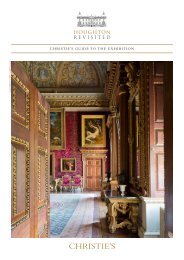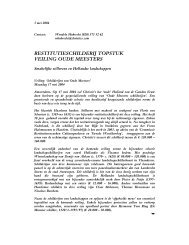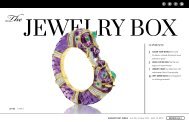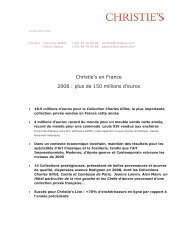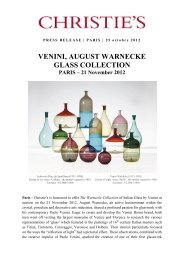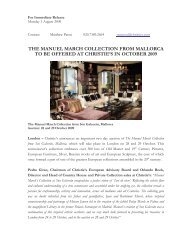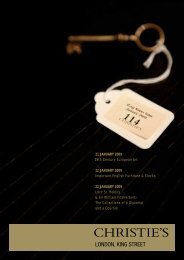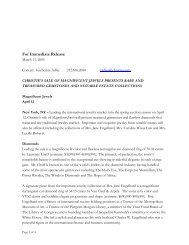THE EXCEPTIONAL SALE 2013 - Christie's
THE EXCEPTIONAL SALE 2013 - Christie's
THE EXCEPTIONAL SALE 2013 - Christie's
You also want an ePaper? Increase the reach of your titles
YUMPU automatically turns print PDFs into web optimized ePapers that Google loves.
the De Beers diamond as the centrepiece of the magnificent ‘Patiala Necklace’. The Maharaja was also an avid<br />
and early motorcar enthusiast; indeed legend has it that he would travel in a motorcade of 20 Rolls Royces.<br />
However, in 1930 he had a falling out with Rolls Royce who he felt slighted him by refusing to accept an<br />
order. Such was his power and influence in India that a campaign by him forced the Viceroy to pressure Rolls<br />
Royce to change their decision.<br />
SCULPTURE<br />
A beautiful, over-lifesize statue by Girolamo Campagna (1549 - 1621), is an exciting recent<br />
discovery: it is almost certainly one of the eight figures which the young Veronese sculptor<br />
carved between 1582 and 1584 for the funerary monument to Doge Nicolò Da Ponte<br />
(1491-1585), formerly in the Venetian church of Santa Maria della Carità (estimate:<br />
£600,000 – 1 million, illustrated left). Completed by April 1584, the monument dominated<br />
the right nave of the monastic church for over two centuries. In 1807, however, the Carità<br />
and its associated buildings were chosen as the site for the new Accademia di Belle Arti,<br />
which resulted in the removal of all the monuments, altars and tombs inside the church. It<br />
was believed, until now, that all of the statues by Campagna had been lost. Campagna was<br />
one of the most significant sculptors to have worked in Venice in the 16 th and early 17 th<br />
centuries. Gifted at working in marble, bronze and stucco, by the last decade of the<br />
Cinquecento, he had taken over from Alessandro Vittoria (c. 1525-1608) as the city’s<br />
leading sculptor. He continued to receive major commissions from the state, church and<br />
private patrons until his death in 1621.<br />
A magnificent bronze model of an écorché horse relates to ‘The anatomy of a<br />
horse in patinated metal above a carved marble quadrilateral plinth’ that was<br />
documented in an inventory of 1810 of the workshop of Giuseppe Valadier,<br />
the celebrated Roman bronze founder, architect and designer (estimate:<br />
£500,000 – 800,000, illustrated right). It is one of four casts known to exist on<br />
this scale and is the only one in private hands. Since the Renaissance artists have<br />
been fascinated by the structural qualities of human and animal bodies and<br />
some, such as Leonardo da Vinci, took part in dissections of the body to aid<br />
their study. The first documented écorché models were made in Italy in the<br />
16 th century, often in bronze. Later, the celebrated painter of horses, George<br />
Stubbs (1724-1806), made a remarkable series of engravings of The Anatomy of<br />
the Horse.<br />
PORCELAIN<br />
A pair of ormolu-mounted Sèvres porcelain vases combine colourful<br />
Chinoiserie scenes with faux-lacquer decoration and are also the only known<br />
‘vases fond noir Chinois en or’ surviving in private hands (estimate: £500,000 –<br />
800,000, illustrated left). In the early 1790s, Sèvres produced a selection of table<br />
wares and vases with sumptuous decoration in the manner of Asian lacquer.<br />
Created by painting different shades of gold and platinum on a black ground, the<br />
effect is arguably one of the richest decorations on porcelain ever achieved and<br />
technologically one of the most complex. Of the approximately 40 entries in the<br />
Sèvres records for vases and other pieces of form decorated using this technique,<br />
only 23 are known to have survived, of which nearly all are now in public collections. Only 17 vases have<br />
survived and the present pair are the only ‘vases à bandeau’ recorded as decorated in this style.




